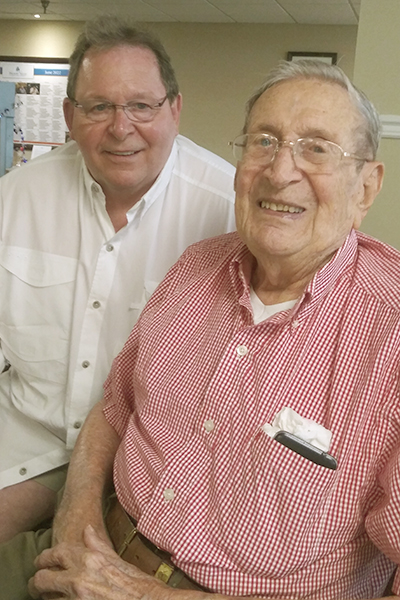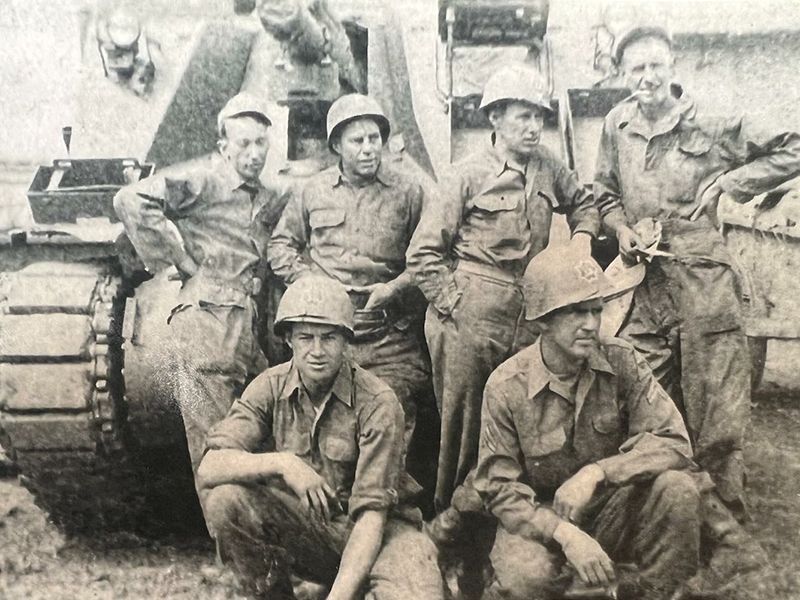Monday is his 100th Fourth of July
On Monday, Ralph Painter will celebrate his 100th Fourth of July. However, there's one Independence Day he distinctly can't remember – in France in 1944, headed toward Nazi Germany.

“We didn't even know what day it was,” he replied with a laugh at the retirement center where he lives in Chattanooga. Painter spoke with the Daily Citizen-News recently with the help of his great-nephew, Brad Lewis of Dalton. The brother of Mose Painter (whose grandson is Lewis) and an innovator in the carpet industry, Ralph Painter worked with him in Dalton after the war. But the family originally came from West Virginia.
“I was born in Spice Run on Nov. 13, 1921,” Painter began. “It used to be on the map, but it's not there anymore. When you go to Snowshoe (ski resort) and look straight down where that incline is, that's where I was born, on the Greenbrier River.”
“They call that area Little Switzerland,” Brad said. “His family was in logging up there, so they needed somebody of his father's skill set at Conasauga Lumber Company.”
The family moved to the town of Conasauga in Polk County, Tenn., in 1924 because their father, Sam Painter, was a lumberman who “walked” timber and estimated it for sale.
“My daddy never drove a car in his life,” Ralph said. “The old (lumber) mill shut down, and we owned the only house in Conasauga that didn't belong to the company. A doctor gave it to my mom. My daddy told him we couldn't afford it, and he gave it to my mother. It was still standing but it burned down, I think somebody was making pot (marijuana) in it.”
Sam Painter went to work for President Franklin Roosevelt's Civilian Conservation Corps.
“He made $135 a month (most men were paid $1 a day) building roads around Chilhowee Lake northeast of Chattanooga,” Ralph said. “The day after (the attack on) Pearl Harbor, I had a '36 Ford convertible; it was blue and had black fenders – man, I was a cat! – and I told my mom, 'I'm going to get a job with TVA (Tennessee Valley Authority).' I drove up to Appalachia Dam, and I bet there was 300 people wanting a job. They all wanted to be truck drivers, none of them wanted to be a laborer. I was the last one, and the old personnel man was closing up his books and he said, 'Now what kind of job do you want?' kinda hateful-like, and I said anything you got. He said you're the only honest person that's been up here, you wanna go to work at midnight? I said yep, and he hired me in at 50 cents an hour.
“I worked, and got up to 85 cents (before) I got drafted in 1942. You know what my mom used to tell everybody? 'Ole Ralph has never been broke – he might have but a quarter in his pocket, but he's never been broke.'”
With his earnings, he'd just bought a new '41 Ford for $815. Painter got on a train at Fort Oglethorpe and rode to Fort Bragg, N.C. for Army basic training, then went to armored force school at Fort Knox, Ky. He joined the 87th Field Artillery of the 400th Armored Artillery as a crewman on the M-7 Priest (long-range 105mm howitzer).
“It was the same as a Sherman (tank), but didn't have a turret on it,” said Painter, who was a mechanic and the motor sergeant whose unit was in the second wave of D-Day on June 8, 1944, two days after the initial invasion.
Hitting the beach in France
“They loaded us up on a 'victory ship' down in New Orleans, and we thought we was going to Italy … I was in one of the' first two tanks that went into Utah Beach,” he recalled. “They put us on an LCT (Landing Craft Tank) and the name of it was 'Son of a Beach.' One of them pulled up beside us and I asked the driver, 'Hey boy, how many of these things did you have this morning?' He said 23. I said, 'How many you got left?' and he said 'Two.'”
The luck of a draw between officers likely saved Painter's life – and his fellow armored soldiers.
“There was two armored artillery units,” Painter said. “The two colonels (commanding officers) drew straws to see which went to Utah (Beach) and which went to Omaha (Beach). Omaha was the one that was down where the wall (cliff) was. Our colonel got Utah, and that 400th got completely wiped out; I think (the Germans) killed every one of them. The Lord took care of me there, didn't he?”
“Absolutely,” Brad affirmed. “He took care of you in a lot of ways.”
Painter said the driver of their LCT wanted to let the M-7 and troops off around 200 yards from the beach, so he found a 12-foot plank and used it to gauge the depth.
“I couldn't hit the bottom when I stuck it down there!” he said. “That driver said 'I ain't-a goin' in no more,' so my captain took out his .45 (pistol) and put it up to his head and said, 'You crank this thing back up or I'll blow your damn head off!' He changed his mind and cranked 'er back up. We had that old tank water-proofed for about six feet of water, because we had it all bondo-ed up (as caulk).”
In around 100 more yards the LCT hit a mine and everyone had to inflate their life vests. However, the captain inflated his the wrong way and Painter had to use a knife to cut a hole in the vest to keep it from choking him.
“The boys didn't like the captain and said (later), 'Why didn't you let it kill him?' I said, 'Well, I felt sorry for him,'” Painter remembered.
The “worst part” of the war for Painter was his involvement in the Germans' desperate attempt to regain territory in the Battle of the Bulge. His armored unit was in support of the 2nd Armored Division.
“We were in what they called a 'bastard outfit' – we wasn't in any (infantry) division,” he said. “Our thing was if they were having trouble anywhere they'd call us and we'd run over there and help them out … We could really move fast! We shot 161,000 rounds, now that's a lot of shells during the war. They said that was the most that any unit had shot.
“It was cold, 30 below zero, and that's where I got my feet all messed up (from frostbite).”
There was always the threat of enemy attacks, especially on the armor crews who were lobbing shells.
“A lot of times we moved at night,” Painter divulged. “Artillery had to move at night because if you got out in the daytime even the (German) civilians would rat on us. It got so bad that if we had 18 tanks going down the road and the Germans (pilots) found out, they'd start knocking the back tank out. So we turned this one tank around and started backing it up and went real slow (to fire at incoming planes).”
Painter said of his time on the European Front, “Out of 365 days, I slept in a bed with sheets two nights.”
Toward the end of the war, Painter and his fellow soldiers came upon a troubling discovery while they were working on a tank near an old coal mine shaft.
“They told us there was some Germans down in there,” he said. “I thought about what an old man that had been in World War I told me the day I left for the Army – 'You'll be better off being a live coward than a dead hero' – but something just told me to go down in there. We got our flashlights and maybe went around 100 yards, and there was about 30 women scared to death because the Germans had been raping them. So we got them out. It was very sad.”
Painter met war hero Audie Murphy on the ship back to the States after the fighting was over. At one time, there were five Painter brothers in the war – Ralph, Ted, Tommy, Andy and Johnny – and his mother had five “stars” on a window signifying their service.
Back to civilian work
Ralph's brother Mose had been sick and wanted him to come to Dalton, so he went to work for Mose. Brad said they were making bath mats, an early specialty item in the carpet industry, and everyone wanted them.
“A fellow from Chicago came in there and gave him $20,000 (to make them), and I said, 'Mose, we need to put on a 24-hour shift, it'll make you some money.' You know what? Money didn't mean nothing to him,” Ralph recalled.
“He didn't care about money,” Brad said of his grandfather.
(Always the innovator, Mose Painter almost got into big trouble with the federal government when he developed the flip-lid and chute for drop-off mailboxes on the street so people didn't have to get out of their cars to post their letters, Brad said of his granddad's time in Dalton. Now they're standard operating procedure around the country.)
Later, Ralph Painter ran a dry-cleaning business in Benton, Tenn., and eventually went back to work for TVA. He was asked his secret for a long, productive life.
“A lot people have asked me that, and I always tell them the same thing – oatmeal!” he said with a hardy laugh.
Staff Sgt. Ralph Painter was awarded five bronze Battle Stars and a separate Bronze Star by the Army for his combat actions in Europe. A commendation letter noted he and his crew were instrumental in getting damaged armor back into service quickly, resulting in saving the lives of Allied troops.
Before his retirement, he was 100% disabled due to frostbite in his feet from temperatures plunging to 20- to 30-degrees below zero during the Battle of the Bulge. His wife, Elizabeth Campbell Painter, passed away in 2006.
“The Lord has blessed me all of my life,” he said. “May God bless you also.”

